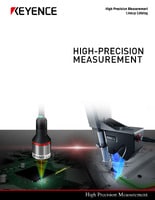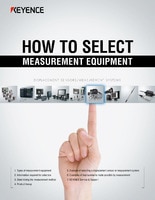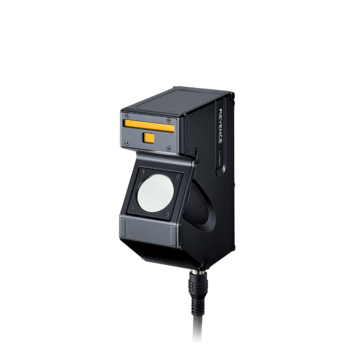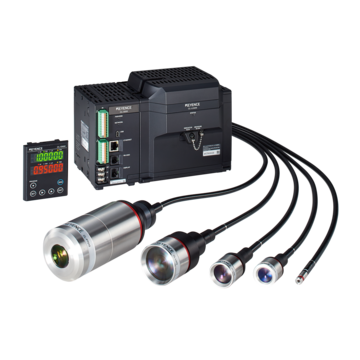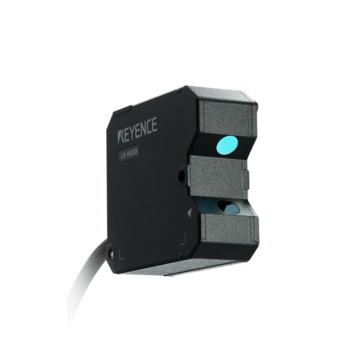Measurement Sensors
Dimension Measurement
Displacement Measurement
4 Types of Distance Sensors & How to Choose the Right One
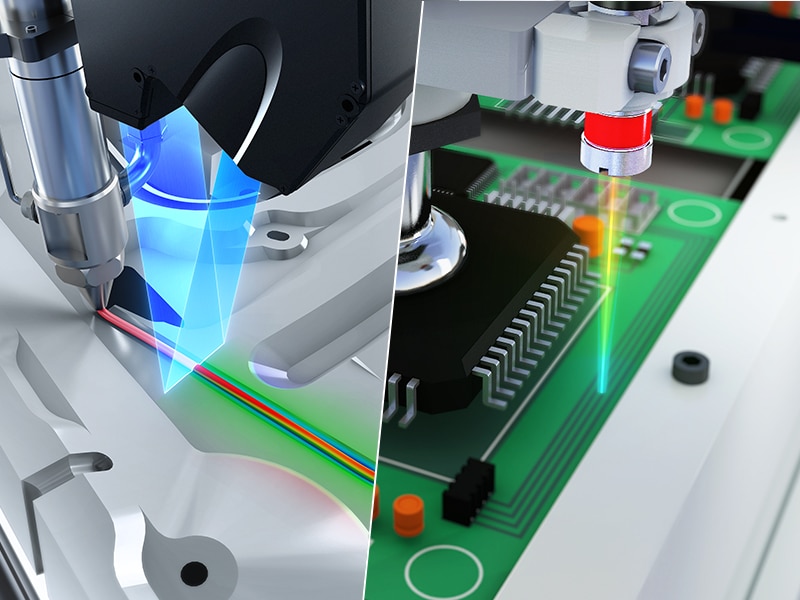
Many different types of distance measurement sensors exist. Of course, not all sensors are the same; different sensor types have their own unique advantages and drawbacks.
In this article, we’ll introduce the different types of distance measurement sensors, what they are, how they work, and some of the most common applications that rely on non-contact distance measurement.
What Is a Distance Sensor?
At their most basic level, distance sensors are transducers (i.e., devices that convert one form of energy into another). They work by outputting a signal at a target object and reading how the reflected signal changes upon return.
Unlike traditional distance measurements (which involve tools like measuring tape or calipers) distance sensors never physically touch the part they’re measuring.
Changes can be measured in the form of the time it takes for the reflected signal to return, the intensity of the reflected signal, or the phase change of the signal after being reflected.
We’re here to provide you with more details.
Reach out today!

Different Types of Distance Measurement Sensors
Distance measurement sensors feature different kinds of measuring technology. Some use sound while others use light. Here’s a rundown of each:
Ultrasonic Distance Sensors
Ultrasonic distance measurement sensors emit a high-frequency soundwave and record the time it takes before the soundwave is reflected to the sensor.
Distance is measured by calculating the time it took for the soundwave to return against the speed of sound in ambient conditions. As such, ultrasonic distance sensors are great for low-power applications or applications in dim lighting. However, they have a limited detection range and slow refresh rate, making them inadequate for fast-moving objects.
Infrared (IR) Distance Sensors
IR distance sensors measure distance based on triangulated reflected IR light. An IR LED emits a beam which reflects off a target and is picked up by a receiver or other photosensitive element.
IR distance sensors are generally small and can function during both day and night. They’re also able to measure complex geometry. However, IR distance sensors have a limited range and are easily affected by environmental conditions.
Laser Distance Sensors
Laser distance sensors - also called laser displacement sensors - may work in several different ways. Comon methods include time-of-flight (in which the sensor derives distance from the time it takes light to reflect) and triangulation (in which distance measurements are achieved by analyzing the angle of the reflected laser beam).
Laser distance sensors deliver precise and stable results across different applications and operating environments. They typically have a much longer measurement range. However, they do pose a risk to the eye safety of operating personnel and usually feature a large form factor.
Proximity Sensors
Proximity sensors are commonly associated with distance sensors due to seemingly similar functions; however, it’s important to note that proximity sensors do not actually measure distance. Instead, they simply sense if an object is within their sensing range, not the distance between objects or between an object and the sensor.
Discover more about this product.
Click here to book your demo.

Distance Sensor Applications
Distance measurement applications differ significantly based on the capabilities of a particular sensor. For example, ultrasonic distance sensors are ideal for smart cars, unmanned aerial vehicles, drones, and robotics that don’t require a high degree of precision.
On the other hand, infrared sensors are used in TVs, computers, security systems, and monitoring and control applications. Laser distance sensors are useful in applications that require an extremely high degree of precision (such as machining and engineering) as well as manufacturing and construction industries.
Choosing the Best Distance Sensors
There are several factors you need to consider when choosing the best distance sensor for your application.
- Resolution
- Resolution refers to the smallest changes in distance that a sensor is capable of detecting. For example, Infrared sensors typically have a resolution of about 5 mm (though there are more precise IR sensors on the market). Laser sensors may have a resolution of about 1 mm. In fact, some laser sensors can detect micron-level changes.
- Sampling rate/Refresh rate
- This metric is usually measured in Hz/s and comes into play when measuring the distance between moving objects. The higher the number of readings the sensor receives per second, the more precise the distance measurement is when approaching or moving away from an observed object.
- Range
- In the context of distance sensors, range refers to the maximum distance at which different types of distance measurement sensors can return accurate and reliable readings. For example, LiDAR scanners have detection distances of up to 2000 m with ±2 cm accuracy.
- Target material
- Reflective, transparent, and absorptive surfaces can significantly affect a sensor’s performance. Make sure to choose a sensor suitable for the type of material you’re measuring the distance from.
Implementing KEYENCE Distance Sensors
High-precision distance measurement is important across several different industries, as it ensures the quality and consistency of products, precise alignment, and accuracy in scientific research.
If you want to learn more about different types of distance sensors, don’t hesitate to ask KEYENCE—our experienced team can help you choose the best type of distance measurement sensor for your particular application.
We’re here to provide you with more details.
Reach out today!

Related Products
Applications
Dimension Measurement
- Thickness and Width Measurement
- Step Height Measurement
- Inner and Outer Diameter Measurement
- Measuring Angles
- Meandering/Edge Measurement
Displacement Measurement
- Positioning and Stroke Length Measurement
- Vibration and Runout Measurement
- Deflection Measurement
- Measuring Eccentricity

